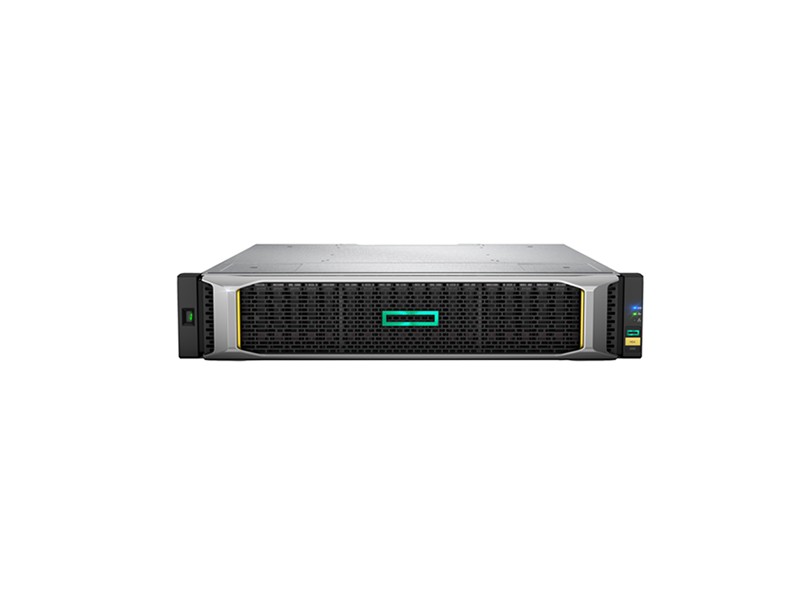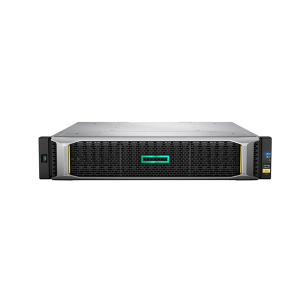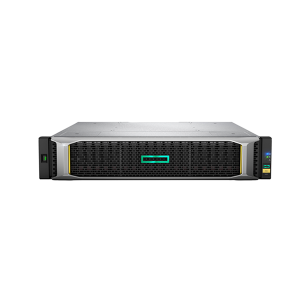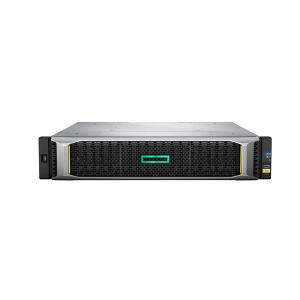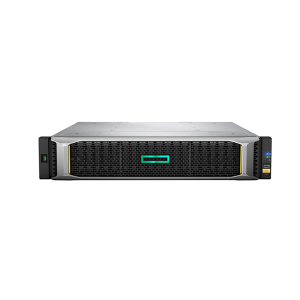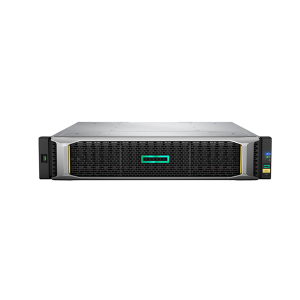HPE MSA 1050 8Gb Fibre Channel Dual Controller LFF Storage (Q2R18A)
114,240,000₫ (giá chưa bao gồm VAT)
Capacity: 480 TB Maximum including expansion
Maximum total HDDs per array : 48 LFF maximum including expansion
Host interface: 8 Gb Fibre Channel 4-ports
Drive description: 12 LFF SAS/MDL SAS/SSD supported
RAID Levels supported: RAID 1, 5, 6, 10
Storage controller: 2 HPE MSA 1050 2-port 8 Gb FC Controller
Storage expansion options: HPE MSA 2050 SFF Disk Enclosure or HPE MSA 2050 LFF Disk Enclosure
SAN backup support: Yes
Systems Insight Manager support: Yes
Compatible operating systems: Microsoft Window Server 2016 Microsoft Windows Server 2012 Red Hat Linux SuSE SLEX Linux VMware
Power Supply: HPE Hot-plug , 220VAC 1.67A,337W (2/2)
Form factor: 2U rack height
Warranty: 3-year parts, 3-year labor, 3-year onsite support
Hãng sản xuất: HPE
Tình trạng: Có sẵn
Bảo hành: 36 tháng chính hãng
| The HPE MSA 1050 Storage brings affordable flash storage down to ever lower customer segments. The MSA 1050 is designed to meet entry-level storage requirements and budgetary constraints. With the lowest storage array price points in the HPE Storage portfolio and field-proven ProLiant compatibility, the MSA 1050 is the platform of choice for smaller SAS, iSCSI and FC deployments.
The HPE MSA 1050 features 8Gb Fibre Channel, 12 Gb SAS, and 1GbE and 10GbE iSCSI at previously unattainable entry price points. The array allows users to take advantage of the latest storage technologies in simple and efficient ways by providing a good balance between performance and budget resulting in a highly favorable $/GB return on their investment. HPE MSA Storage has been the industry-leading entry storage Fibre Channel platform for the past eight years, with nearly 500,000 storage systems sold worldwide. Starting at under $5,500* USD, the MSA 1050 provides affordable application acceleration. It’s seriously simple and affordable flash-ready storage to help you get the most performance for the lowest cost. · Configurations starting at $5,500 * – Factory-configured, dual controller array with 4 host ports of either 8Gb FC, 1GbE, 10GbE or 12Gb SAS protocols – Small Form Factor (SFF) or Large Form Factor (LFF) models available · Simple, proven Gen10 ProLiant compatible shared storage – MSA continues its heritage of providing affordable, easy to use shared storage without a big learning curve – Intuitive setup and management for ProLiant administrators. – New look-and-feel will fit right in with your Gen10 ProLiant servers · Access to MSA 1050 advanced data services with simplified licensing approach – Leverage flash storage with easy to use, easy to maintain tiering and read cache technologies – No storage expertise necessary, system dynamically responds to workload changes, so you don’t have to · Expandable and upgradable to meet new demands – Add new HDDs or disk expansions to your MSA 1050 – Upgrade system to the MSA 2050 through data-in-place upgrade: a simple 15 minute upgrade! – No time-consuming migrations required |
| NOTE: * US Street Price (MSA 1050 base unit, dual 1GbE iSCSI controllers, four 300GB HDDs); prices are subject to change without notice. |
| What’s New in the MSA 1050 array family |
| · Up to 30% improvement in random read and random write workloads with latest firmware release, depending on protocol.
· New I/O Workload tool in the User Interface to help users benefit from tiering on the MSA. · New LDAP Support. |
|
|||||||||||||||||||||||||||||||||||||||||||||||||||||||||||||||||||||||||||||||||||||||||||
| HPE MSA 1050 Storage | |||||||||||||||||||||||||||||||||||||||||||||||||||||||||||||||||||||||||||||||||||||||||||
| 1. | AC Power supply | 5. | CLI Port (mini USB) | ||||||||||||||||||||||||||||||||||||||||||||||||||||||||||||||||||||||||||||||||||||||||
| 2. | Controller Module A | 6. | Network Management Port | ||||||||||||||||||||||||||||||||||||||||||||||||||||||||||||||||||||||||||||||||||||||||
| 3. | Controller Module B | 7. | Cache Status LED | ||||||||||||||||||||||||||||||||||||||||||||||||||||||||||||||||||||||||||||||||||||||||
| 4. | Host Connection Ports (2) | 8. | SAS Expansion Port | ||||||||||||||||||||||||||||||||||||||||||||||||||||||||||||||||||||||||||||||||||||||||
| 9 | AC Power Supply | ||||||||||||||||||||||||||||||||||||||||||||||||||||||||||||||||||||||||||||||||||||||||||
| MSA 1050 | Descriptions | Part Number |
| Storage Models | HPE MSA 1050 8Gb Fibre Channel Dual Controller LFF Storage | Q2R18A |
| NOTE: Includes LFF Array Chassis, two MSA 1050 FC 2-port controllers, SFPs installed, drives not included. | ||
| HPE MSA 1050 8Gb Fibre Channel Dual Controller SFF Storage | Q2R19A | |
| NOTE: Includes SFF Array Chassis, two MSA 1050 FC 2-port controllers, SFPs installed, drives not included. | ||
| HPE MSA 1050 12Gb SAS Dual Controller LFF Storage | Q2R20A | |
| NOTE: Includes LFF Array Chassis, two MSA 1050 SAS 2-port controllers, SFPs not needed with SAS controllers, drives not included. | ||
| HPE MSA 1050 12Gb SAS Dual Controller SFF Storage | Q2R21A | |
| NOTE: Includes SFF Array Chassis, two MSA 1050 SAS 2-port controllers, SFPs not needed with SAS controllers, drives not included. | ||
| HPE MSA 1050 1GbE iSCSI Dual Controller LFF Storage | Q2R22A | |
| NOTE: Includes LFF Array Chassis, two MSA 1050 1GbE 2-port controllers, SFPs installed, drives not included. | ||
| HPE MSA 1050 1GbE iSCSI Dual Controller SFF Storage | Q2R23A | |
| NOTE: Includes SFF Array Chassis, two MSA 1050 1GbE 2-port controllers, SFPs installed, drives not included. | ||
| HPE MSA 1050 10GbE iSCSI Dual Controller LFF Storage | Q2R24A | |
| NOTE: Includes LFF Array Chassis, two MSA 1050 10GbE 2-port controllers, SFPs installed, drives not included, direct attached copper cables are supported in 10GbE Controller systems. | ||
| HPE MSA 1050 10GbE iSCSI Dual Controller SFF Storage | Q2R25A | |
| NOTE: Includes SFF Array Chassis, two MSA 1050 10GbE 2-port controllers, SFPs installed, drives not included, direct attached copper cables are supported in 10GbE Controller systems. |
| All MSA 1050 models offer a common set of valuable features: | |
– Includes SFF or LFF array chassis, depending on model – Two FC, iSCSI or SAS controllers, depending on model ú Two host ports per controller ú Each controller supports 8 Gb FC, 1GbE iSCSI, 10GbE iSCSI or 12Gb SAS host connectivity, depending on model – 6 GB cache per controller. (4GB Read/Write plus 2GB System) – Battery-free cache backup with super capacitors and compact flash
|
|
| Application
Solutions |
The HPE MSA 1050 Storage is the ideal solution for customers running Oracle, Microsoft, SAP environments and those customers who are deploying virtual server technologies like VMware and Hyper-V. The MSA 1050 delivers enterprise functionality that enhances virtual environments, simplifies management, and reduces costs. Easy to deploy, scale and maintain, HPE MSA 1050 Arrays ensure that crucial business data remains available.
Hewlett Packard Enterprise has developed best-in-class expertise in Oracle, Microsoft, SAP, and Virtualization Hypervisor technology through extensive testing with the HPE MSA 1050, HPE servers, and management software; high availability and disaster recovery solutions; and backup and recovery on the Oracle, Microsoft, and SAP application platforms. |
| Learn more | To learn more about specific HPE Storage Solutions that are built with Oracle, Microsoft, SAP and Virtualization environments in mind, visit the solution sites supporting each of these applications.
HPE MSA Storage hyperlink to: http://www.hpe.com/storage/MSA |
Software
| Product Technology | |||||||||||||||||||||||||||
| MSA 1050 Models | MSA 1050 Storage offers 8 factory configured models:
· MSA 1050 8Gb FC with 4-ports per array system, SFF or LFF · MSA 1050 12Gb SAS with 4-ports per array system SFF or LFF · MSA 1050 1GbE iSCSI with 4-ports per array system SFF or LFF · MSA 1050 10GbE iSCSI with 4-ports per array system, SFF or LFF |
||||||||||||||||||||||||||
| Modular
Chassis |
2U rack height. 12 LFF or 24 SFF drive bays, accommodating SSDs, SAS and SAS MDL Drives
NOTE: The MSA 1050 does not support single controller configurations. Single-controller support is provided only when a controller fails over to its partner controller |
||||||||||||||||||||||||||
| Drives available | The MSA 1050 Storage systems support both the MSA 3.5-inch LFF drives, and the MSA 2.5-inch SFF drives.
· Solid State Drives (SSDs) deliver exceptional performance for applications requiring high random read IOPs performance. · Serial Attached SCSI (SAS) enterprise-class drives are designed for high demand, 24×7 usage. · SAS Midline (MDL) drives are usually reserved for archival of data as they are relatively inexpensive and are available in very large capacities. |
||||||||||||||||||||||||||
| Optional Disk Enclosures | Just as the user has a choice of chassis for the array enclosure (LFF or SFF drive bays), they also have a choice of expansion disk enclosures accommodating either drive size. Both the MSA 2050 LFF Disk Enclosure and MSA 2050 SFF Disk Enclosure can be hot-added to an operating array. SFF and LFF Array enclosures and Disk Enclosures can be mixed without limitations.
MSA 2050 LFF Disk Enclosure. This 2U enclosure is designed to support twelve HPE Storage LFF drives and accepts MSA dual-ported 12Gb SSD, Enterprise SAS or SAS Midline (MDL) hard drives. The pre-configured MSA 2050 LFF Disk Enclosure has two I/O modules and supports the MSA 1050 dual controller arrays. · The MSA 2050 LFF Disk Enclosure can be attached to the MSA 1050 LFF or SFF storage models. · Each MSA 2050 LFF Disk Enclosure ships standard with two .5m mini-SAS to mini-SAS cables for connection to the MSA 1050 array expansion port or existing disk enclosure cascade port. · LFF and/or SFF Disk Enclosures can be mixed up to the maximum of 3 total Disk Enclosures. |
||||||||||||||||||||||||||
| HPE MSA 2050 LFF Disk Enclosure | Q1J06A | ||||||||||||||||||||||||||
| HPE MSA 2050 SFF Disk Enclosure This 2U enclosure is designed to support twenty four HPE Storage 2.5-inch SFF drive bays and accepts MSA dual ported 12Gb SSD, Enterprise SAS, or SAS Midline (MDL)hard drives. The pre-configured MSA 2050 SFF Disk Enclosure has two I/O modules and supports the MSA 1050 dual controller arrays.
· The MSA 2050 SFF Disk Enclosure can be attached to the MSA 1050 LFF or SFF storage models. · Each MSA 2050 SFF Disk Enclosure ships standard with a two .5m mini-SAS to mini-SAS cables for connection to the MSA 1050 array expansion port or existing disk enclosure cascade port. · LFF and/or SFF Disk Enclosures can be mixed up to the maximum of 3 total Disk Enclosures. |
|||||||||||||||||||||||||||
| HPE MSA 2050 SFF Disk Enclosure | Q1J07A | ||||||||||||||||||||||||||
| Scalability | The MSA 1050 array configurations are designed to allow an installation to begin with smaller capacity and be able to grow gradually as needed. The flexibility of SSD, Enterprise SAS or SAS Midline (MDL) drives technology, form factors, sizes, speeds, and costs per GB allows a system to easily fit in almost any budget.
|
||||||||||||||||||||||||||
| Disk Group | A Disk Group is a collection of disks in a given redundancy mode (RAID 1, 5, 6, 10). Disk Group RAID level and size can be created based on performance and/or capacity requirements. Multiple Disk Groups can be allocated into a storage pool for use with the Virtual Storage features. | ||||||||||||||||||||||||||
| LUNs | The MSA 1050 arrays support 512 volumes and up to 512 snapshots in a system. All of these volumes can be mapped to LUNs. Maximum LUN sizes up to 140TB (128 TiB). Thin Provisioning allows the user to create the LUNs independent of the physical storage. | ||||||||||||||||||||||||||
| Storage Pools | Storage pools are comprised of one or more Disk Groups. A volume’s data on a given LUN can now span all disk drives in a pool. When capacity is added to a system, users will benefit from the performance of all spindles in that pool.
The MSA 1050 supports large, flexible Volumes with sizes up to 128TiB and facilitates seamless capacity expansion. As pools are expanded data automatically reflows to balance capacity utilization on all drives. |
||||||||||||||||||||||||||
| RAID 1, 5, 6, 10 | The MSA 1050 features several important additional RAID levels. RAID 6 offers the highest level of RAID protection. It allocates two sets of parity data across drives and allows simultaneous write operations. It can withstand two simultaneous drive failures without downtime or data loss. RAID 10 is mirroring and striping without parity and allows large Disk Groups to be created with high performance and mirroring for fault tolerance. RAID 5 combines the block striping and parity. Because data and parity are striped across all of the disks, no single disk is a bottleneck. Striping also allows users to reconstruct data in case of a disk failure. | ||||||||||||||||||||||||||
| Performance | The performance figures provided here are for reference as many variables exist between array configurations, workloads, hard drive types, disk group setup parameters and host system setup. Hewlett Packard Enterprise has traditionally published a set of end-to-end MSA performance specifications that are fed into HPE Sizer tools which are based on conservative real-world configurations. For consistency, the MSA performance numbers have been documented in both Benchmark and End-to-End Performance tables. These numbers are subject to change without notice.
MSA 1050 End-to-End Performance Results (using VE270 firmware release)
End-to-End performance notes 1) Performance results were generated using internal HPE test tools. Number and type of applications, drive type and number of drives, operating system used, and the number of hosts will affect overall performance. This table is provided strictly as a test-lab comparison using VE270 firmware. 2) Dual Controller configuration, (4) 400GB Mixed Use SSDs, RAID: 1, two drives per Disk Group; one Disk Group per pool, 2 volumes per pool, block size: 8k, average latency under 5ms, Windows Server 2016 host, 8Gb FC connect to array 3) Dual Controller configuration, (36) 15k HDD, RAID: 5, nine drives per Disk Group, 2 Disk Groups per pool, 2 volumes per pool, block size: 256k, average latency under 30ms, Windows Server 2016 host, 8Gb FC connect to array 4) Sequential performance numbers were generated using segmented sequential workloads. For segmented sequential workloads with a queue depth greater than 1, each sequential stream is targeted to operate on a separate LBA range. Other types of sequential workloads that target specific LBA ranges may achieve higher results. |
||||||||||||||||||||||||||
| End-to-End Performance Figures using Virtual Storage (using VE270 firmware) | |||||||||||||||||||||||||||
| HPE MSA 1050 End-to-End Performance Figures 1 | ||||||||
| Controller Model | HPE MSA 1050 SAN | HPE MSA 1050 SAS | ||||||
| Host Protocol 2 | 8 Gb FC | 10 GbE iSCSI | 1 GbE iSCSI | 12 Gb SAS | ||||
| Drive Technology | HDD | SSD | HDD | SSD | HDD | SSD | HDD | SSD |
| MSA 1050 RAID 10 Performance Results 3,4,9,10,11 ** NOTE: RAID 1 was used for SSD testing. | ||||||||
| Random Reads IOPS | 31,800 | 91,856 | 31,700 | 86,981 | 31,500 | 53,523 | 31,900 | 93,548 |
| Random Writes IOPS | 29,653 | 39,146 | 29,496 | 37,461 | 26,502 | 34,565 | 28,124 | 38,935 |
| Random Mix 60/40 IOPS | 26,992 | 55,796 | 27,050 | 52,709 | 26,847 | 49,065 | 26,622 | 55,751 |
| Sequential Reads MB/s | 3,079 | 3,760 | 441 | 4,682 | ||||
| Sequential Writes MB/s | 2,771 | 2,971 | 430 | 2,961 | ||||
| MSA 1050 RAID 5 Performance Results 5,6,9,10,11 | ||||||||
| Random Reads IOPS | 29,903 | 85,876 | 29,657 | 81,636 | 29,421 | 53,517 | 29,100 | 87,691 |
| Random Writes IOPS | 14,154 | 20,938 | 14,525 | 20,369 | 14,179 | 19,326 | 13,562 | 20,869 |
| Random Mix 60/40 IOPS | 17,378 | 36,294 | 17,642 | 34,869 | 17,486 | 32,942 | 16,932 | 36,147 |
| Sequential Reads MB/s | 3,078 | 3,675 | 441 | 3,846 | ||||
| Sequential Writes MB/s | 2,850 | 2,420 | 441 | 3,125 | ||||
| MSA 1050 RAID 6 Performance Results 7,8,9,10,11 | ||||||||
| Random Reads IOPS | 29,930 | 85,706 | 29,713 | 80,895 | 29,569 | 53,512 | 29,918 | 86,401 |
| Random Writes IOPS | 10,197 | 17,992 | 10,192 | 17,471 | 10,163 | 16,732 | 7,597 | 17,902 |
| Random Mix 60/40 IOPS | 12,767 | 32,697 | 13,336 | 31,329 | 13,308 | 29,895 | 12,310 | 32,496 |
| Sequential Reads MB/s | 3,078 | 3,728 | 441 | 4,263 | ||||
| Sequential Writes MB/s | 2,683 | 2,320 | 441 | 2,783 | ||||
| NOTE: Number and type of applications, drive type and number of drives, operating system used, and the number of hosts will affect overall performance. This table is provided strictly as a test-lab comparison. These numbers reflect a full array configuration with the maximum number of front-end ports and controllers. The test results shown for the HPE MSA 1050 are designed to give a conservative reference point for comparisons. |
| 1. Sequential tests (MB/s) are based on 256K block sizes and random tests (IOPS) are based on 8K block sizes run against the storage. For sequential workloads with a queue depth greater than 1, each sequential stream is targeted to operate on a separate LBA range. Other types of sequential workloads that target specific LBA ranges may achieve higher results. |
| 2. Fibre Channel results were measured using 8 Gb FC Host Bus Adapters. SAS results were measured using 6 Gb SAS Host Bus Adapters. 10 GbE iSCSI results were measured using 10GbE iSCSI Host Bus Adapters. 1 GbE iSCSI results were measured using 1GbE network interface controllers (NICs). |
| 3. MSA 1050 RAID 10 Hard Disk Drive (HDD) random results: Dual Controller configuration, (96) 15K HDD, 12 drives per disk group, 4 disk groups per pool, 2 volumes per pool. |
| 4. MSA 1050 RAID 10 Hard Disk Drive (HDD) sequential results: Dual Controller configuration, (48) 15K HDD, 12 drives per disk group, 2 disk groups per pool, 2 volumes per pool. |
| 5. MSA 1050 RAID 5 Hard Disk Drive (HDD) random results: Dual Controller configuration, (96) 15K HDD, 12 drives per disk group, 4 disk groups per pool, 2 volumes per pool. |
| 6. MSA 1050 RAID 5 Hard Disk Drive (HDD) sequential results: Dual Controller configuration, (36) 15K HDD, 9 drives per disk group, 2 disk groups per pool, 2 volumes per pool. |
| 7. MSA 1050 RAID 6 Hard Disk Drive (HDD) random results: Dual Controller configuration, (96) 15K HDD, 12 drives per disk group, 4 disk groups per pool, 2 volumes per pool. |
| 8. MSA 1050 RAID 6 Hard Disk Drive (HDD) sequential results: Dual Controller configuration, (40) 15K HDD, 10 drives per disk group, 2 disk groups per pool, 2 volumes per pool. |
| 9. MSA 1050 RAID 1 Solid State Drives (SSD) results: Dual Controller configuration, (4) SSDs, 2 SSDs per disk group, 1 disk group per pool, 2 volumes per pool. |
| 10. MSA 1050 RAID 5 Solid State Drives (SSD) results: Dual Controller configuration, (6) SSDs, 3 SSDs per disk group, 1 disk group per pool, 2 volumes per pool. |
| 11. MSA 1050 RAID 6 Solid State Drives (SSD) results: Dual Controller configuration, (8) SSDs, 4 SSDs per disk group, 1 disk group per pool, 2 volumes per pool. |
| Configuration and Management Tools | Management access, out-of-band, Storage Management Utility (SMU), CLI.
Interface Types: USB 100/1000 Ethernet. Protocols Supported SNMP, SMI-S, SSH, SMTP, FTP, SFTP, HTTP, HTTPS, Telnet. |
| Web Browser support | The MSA 1050 arrays come integrated with web browser and CLI based software for storage and RAID management, setup, configuration, and troubleshooting. The MSA 1050 management supports Microsoft Internet Explorer, Mozilla Firefox, and Google Chrome. |
| Hot Plug Expansion and Replacement Support | All MSA 1050 models support hot plug expansion and replacement of redundant controllers, enclosures, fans, power supplies, and I/O modules for simple, fast installation and maintenance. Hot add expansion of disk enclosures is also supported. |
| HPE Server Compatibility | The MSA 1050 supports most HPE ProLiant and BladeSystems servers including
· HPE ProLiant DL, ML Servers · HPE c-Class Blade Servers · Compatibility must be confirmed at: http://www.hpe.com/storage/spock NOTE: depends on protocol. |
| 3rd Party server
support |
The MSA 1050 supports most multi-vendor industry standard Intel and AMD based (x86) servers. Hewlett Packard Enterprise requires the Third-Party Server to be logged and listed on the Microsoft Windows Server Catalog.
· Hewlett Packard Enterprise recommends that the Third-Party Server Vendor is an active member of TSANet. Refer to the TSANet website for details: http://www.tsanet.com · Non-HPE servers will generally be supported if the HPE storage stack is used. This includes supported HPE branded HBAs and drivers, and supported FC switches. |
| OS Support | Refer to the Hewlett Packard Enterprise support statements for complete current OS version support: http://www.hpe.com/storage/spock
NOTE: depends on protocol. |
| Advanced Virtualized Features | Storage on the MSA 1050 is all virtualized including Automated Tiering of Enterprise SAS (Standard Tier) and Midline SAS (Archive Tier), Read Cache and Wide-Striping. Sub-LUN Tiering from SAS Midline to Enterprise SAS drives is also a standard feature.
NOTE: The MSA 1050 supports virtual storage only. Linear storage is not supported on the MSA 1050. NOTE: The purchase of an Advanced Virtualization Upgrade license is not required for virtual storage on the MSA 1050. The Advanced Virtualization Upgrade functionality is included in the base MSA 1050 system as a standard feature. |
|
| Advanced Data Services Suite | The HPE MSA Advanced Data Services Suite can be purchased as an option on the MSA 1050 Storage systems.
The optional Advanced Data Services Suite includes the following functionality: • Performance Tiering between the SSD tier and the Standard or Archive Tier • 512 Snapshots • Remote Snaps |
|
| HPE MSA Advanced Data Services Suite LTU | Q0H99A | |
| HPE MSA Advanced Data Services Suite E-LTU | Q0H99AAE | |
| Performance Tiering and Archive Tiering
|
Disk tiers are comprised of aggregating 1 or more Disk Groups of similar physical disks. The MSA 1050 supports 3 distinct tiers:
1. A Performance tier with SSDs 2. A Standard SAS tier with Enterprise SAS HDDs 3. An Archive tier utilizing Midline SAS HDDs. The MSA 1050 supports sub-LUN tiering and automated data movement between tiers. The MSA 1050 automated tiering engine moves data between available tiers based on the access characteristics of that data. Frequently accessed “pages” will migrate to the highest available tier delivering maximum I/O´s to the application. Configurations which have a mixture of both SSDs and HDDs within the same system being used as a capacity Tier (excluding SSD Read Cache), will require the Advanced Data Service Suite LTU. This rule applies to the system level and therefore the license is required regardless of whether the drives are configured for auto-tiering within the same Pool. All SSD configurations and SSD Read Cache extension do not require a license on the MSA 1050 array. |
|
| Snapshot and Volume Copy |
• All MSA 1050 arrays come standard with 64 snaps.
• A 512 Snapshot license is available as an option on the MSA 1050 • Snapshots create up to 512 point-in-time copies of data • Volume Copy can create up to 128 point-in-time copies of data • Point-in-time copies become standard volumes when they are complete • Recovery is instant – revert data from any previous Snapshot or Volume Copy • Backup ‘snapped’ data to disk, virtual tape, or physical tape without a backup window • If telephone support and software updates are desired for bundled software functionalities like 64 snapshots and volume copy software, a combination HW + SW support care pack must be purchased. |
|
| Remote Snap | • HPE MSA Remote Snap Software is array based software that provides remote replication on the HPE MSA 1050 array products. MSA Remote Snap is a form of asynchronous replication which consists of replication of block-level data from a volume on a local system to a volume on a second independent system. This second system may be co-located with the first system or may be located at a remote site.
• HPE Remote Snap replication technology provides the ability to accomplish key data management and protection capabilities. First, because Remote Snap uses snapshots as the underlying technology it creates multiple local recovery points which can be used for such tasks as to complement daily backups; second, replication provides the ability to access data in a remote site which could be used for dispersed operations; and third but definitely not least important replication allows for business continuance in the event of a failure on the primary site. • In order to perform a replication, a snapshot of the volume to be replicated is taken, creating a point-in-time image of the data. This point-in-time image is then replicated to the destination volume by copying the data represented by the snapshot via iSCSI or Fibre Channel protocols. Replication via the SAS protocol is not supported. The amount of data transferred is minimized though the use of snapshots whenever possible. NOTE: One Advanced Data Services Suite License per array is required for replication. For example, if you have two MSA arrays performing replication (from Primary system to Remote System), you will need a total of 2 licenses.
Product Features • Storage based asynchronous snapshot replication • Support of iSCSI and Fibre Channel interconnects provides flexible options to the application environments. • Snapshot based replication technology means only changed data will be replicated to alternate site • Replication between on MSA 1050 to another MSA is supported (1 to 1 peer connection). • Replication up to four MSA 1050s to a single MSA 2050 is supported. Typical use case is to replicate from “many” branch offices to the home office for the purpose of backing up data from the branches • Advanced scheduler provides several options to IT administrators for business continuance • Flexible architecture allows remote replication between MSA 1050 and MSA 2050 or MSA 2040/1040 arrays using the virtual storage architecture and licensed for Remote Snap. Protects existing investments and enhances business continuity planning objectives. • Snapshot based replication enables both local and remote recovery depending on the need. Snapshot replication isolates problems to a specific point in time which can be selected by the administrator. Additionally snapshot replication supports longer distance replication. • 512 Snapshots and Volume Copy integration provides better efficiencies by combining the management and array technologies to create local copies. • Fast application recovery with minimal or no transaction loss • Creation of disaster tolerant copies of your critical business data • No-single-point-of-failure solution to increase the availability of your data |
|
| HPE OneView for VMware vCenter | HPE OneView for VMware vCenter is a component within the HPE OneView plug-in for vCenter. It provides VMware administrators that are using VMware’s vSphere management console (vCenter) with the ability to see how virtual machines are mapped to datastores and individual MSA 1050 volumes. By providing these clear relationships between VM’s, datastores and storage, the VMware administrator’s productivity increases, as does the ability to ensure quality of service. Roles for administrators can be defined on an individual basis, providing the ability to apply specific permissions for both view and control functions.
HPE OneView for VMware vCenter supports mixed array environments including MSA 1050/2050/2052, MSA 1040/2040/2042 and other HPE Storage systems. When deployed with the MSA 1050 array, HPE OneView provides the following:
– Create/Expand/Delete a Datastore – Create a Virtual Machine from a template
HPE OneView for VMware vCenter is downloadable from Software Depot: https://h20392.www2.hpe.com/portal/swdepot/displayProductInfo.do?productNumber=HPVPR For more information on HPE OneView for VMware vCenter visit: http://h22168.www2.hpe.com/us/en/partners/vmware/ |
|
| HPE StoreFront Manager for Microsoft | HPE StoreFront Manager for Microsoft enables management and monitoring of HPE MSA Storage running in Microsoft Hyper-V environment with a single pane-of-glass view to events/alerts, capacity and health dashboards and detailed virtual infrastructure information. It integrates seamlessly with Microsoft System Center Operations Manager (SCOM) and provides Microsoft administrators the following:
It supports heterogeneous HPE Storage environment including HPE MSA, HPE StoreVirtual, HPE 3PAR StoreServ, HPE StoreOnce, HPE StoreEasy, HPE XP, HPE EVA and HPE StoreEver Storage.
When deployed with the MSA 1050 array, HPE StoreFront Manager provides the following: · Monitors the health, events and alerts for the MSA 1050 – virtual pools, and volumes · Provides detailed information on the VMs provisioned through MSA Storage · Effortless installation and configuration using Powershell
HPE StoreFront Manager for Microsoft for MSA Storage is downloadable from Software Depot: https://h20392.www2.hpe.com/portal/swdepot/displayProductInfo.do?productNumber=System_Center |
|
| vStorage API for Array Integration (VAAI) | The vStorage API for Array Integration (VAAI) is one of the storage application programming interface (API) sets in vSphere. VAAI is an API storage partners can leverage to enhance performance of virtual machine (VM) management operations by delegating these operations to the storage array. With hardware offload, ESX/ESXi hosts perform certain operations faster and consume less server CPU and memory resources, and also storage port and storage fabric bandwidth. VAAI includes high performance and scalable VM data path primitives.
Storage Hardware Primitives for VAAI
UNMAP reclaims space that is no longer on a thinly provisioned VMFS volume |
|
| LDAP Support | LDAP (Lightweight Directory Access Protocol) is an industry standard application protocol for accessing and maintaining distributed directory information services over an IP network. LDAP provides the ability to authenticate MSA users with a central directory.
|
|
| I/O Workload Functionality | A new user interface element called “I/O Workload” has been added to the main screen on MSA’s WBI home screen for GL270 or later firmware. The MSA array controllers keep track of a substantial amount of data pertaining to the I/O dynamics at a logical page level (4MB chunks). From this data, it is possible to provide some visibility to what percent (%) of I/O’s are being processed by what percent (%) of the overall array’s capacity across a 7 day timeline. While some workloads have “transient” data access patterns, many workloads have steady access patterns on small portions of the array’s capacity. This produces “hot” pages in the array which remain hot a large amount of the array’s uptime. Users would see substantial benefits if these pages could be served from the fastest media in the array (ideally SSDs). As has been described in the MSA’s tiering functionality, the MSA array’s tiering engine will work to position the hottest pages on the fastest media at any given time.
The new I/O Workload graph will show a line labeled Capacity and a line plot for each selected workload percentage (100%, 80%, or Other% value). Below are two examples of user scenarios where the I/O Workload Graph might be useful and how to utilize the data the graph provides. 1) New User or SSD Installation a. Once the MSA array is installed and has had workloads running against it for a week’s time, the I/O Workload data will give a representation of what Capacity is servicing 100% of I/O and 80% of I/O. Users may select a custom % value if desired. In a new installation or in an installation with no SSD tier installed, the 80% line is a reasonable starting point for an SSD tier. Based on SSD RAID settings, customers can then calculate a good starting point with regard to SSD tier sizing based on that week’s workload. While not a hard fast rule, it is a good starting point. These values should also be compared to the Best Practices “rule of thumb” which suggest that 5-15% of the array’s capacity should be SSDs for tiered solutions. 2) Users with existing SSD tiering or read caching installed and running a. For arrays running with SSDs installed (tiered or read cache), the I/O Workload graph will have a dotted line which shows the installed SSD capacity. The I/O Workload graphs can be checked periodically to see where the 80% I/O line is with regard to the SSD capacity line. While there are no hard and fast rules which indicate good/bad situations, users can use the graph with other system performance tools to better understand specific dynamics of their installation and the normal dynamics of a system in the day-to-day activities for a specific environment. Interpreting the I/O Workload graphs allow users to strike a balance between the SSD costs versus performance benefits. For example, some customers may be willing to have a couple of days where peak usage is far above the SSD capacity line as it may be acceptable to have slower performance as the system uses HDDs for a larger percentage of the workload I/O. This may be perfectly acceptable for systems sized to optimize $/TB due to budget constraints. Other users may want to optimize the system such that a sizeable percentage of daily I/O have the opportunity to reside on SSD media (sized to 80% or 90%). When combined with other performance monitoring tools, the new I/O Workload function gives users some representation as to how the workloads and the MSA are working together in a user’s real-world environment. |
|
Warranty, Service and Support Information
| Warranty | Three-year limited warranty, parts exchange Next Business day delivery
Enclosures, Hard drives, and Options for the MSA 1050 carry their own warranty. Refer to Hewlett Packard Enterprise Limited Warranty Statement for more information. The MSA 1050 has been designed with customer self-repairable parts to minimize repair time and provide greater flexibility in performing defective parts replacement. Please refer to Hewlett Packard Enterprise limited warranty Statement and parts replacement instructions for further details. NOTE: The warranty of the hard drive options purchased with the MSA 1050 models is different for SAS hard drives versus SAS MDL. SAS hard drive options have a three year warranty and SAS MDL have a one year warranty. NOTE: Firmware updates beyond the 3 year warranty period requires a support contract. |
| Solid State Drives (SSD) Warranty |
3/0/0 warranty; Customer Self Repair (CSR) subject to maximum usage and or maximum supported lifetime limitations, whichever occurs first. Maximum Supported Lifetime is the period in years set to equal the warranty for the device. Maximum usage limit is the maximum amount of data that can be written to the device before reaching the device’s write endurance limit. |
| Service and Support | Protect your business beyond warranty with HPE Support Services
HPE Pointnext provides a comprehensive portfolio including Advisory and Transformational, Professional, and Operational Services to help accelerate your digital transformation. From the onset of your transformation journey, Advisory and Transformational Services focus on designing the transformation and creating a solution roadmap. Professional Services specializes in creative configurations with flawless and on-time implementation, and on-budget execution. Finally, operational services provides innovative new approaches like Flexible Capacity and Datacenter Care, to keep your business at peak performance. HPE is ready to bring together all the pieces of the puzzle for you, with an eye on the future, and make the complex simple. |
| Connect your devices | Unlock all of the benefits of your technology investment by connecting your products to Hewlett Packard Enterprise. Achieve up to 77%1 reduction in down time, near 100%2 diagnostic accuracy and a single consolidated view of your environment. By connecting, you will receive 24x7monitoring, pre-failure alerts, automatic call logging, and automatic parts dispatch. HPE Proactive Care Service and HPE Datacenter Care Service customers will also benefit from proactive activities to help prevent issues and increase optimization. All of these benefits are already available to you with your server storage and networking products, securely connected to HPE support
1 IDC 2 HP CSC reports 2014-2015
Learn more about getting connected at http://www.hpe.com/services/getconnected |
| Optimized Care | HPE Proactive Care with 6 hour call-to-repair commitment, three year Support Service
HPE Proactive Care gives customers an enhanced call experience. When your products are connected to HPE, Proactive Care helps prevent problems and maintains IT stability by utilizing personalized proactive reports with recommendations and advice. This Service combines three years’ proactive reporting and advice with our highest level of hardware support; HPE’s 24×7, six hour hardware call-to-repair. HPE is the only leading manufacturer who makes this level of coverage available as a standard service offering for your most valuable servers and storage, including the HPE MSA 1050 Storage. |
| Standard Care | HPE Proactive Care with 24×7 coverage, three year Support Service
HPE Proactive Care gives customers an enhanced call experience. When your products are connected to HPE, Proactive Care helps prevent problems and maintains IT stability by utilizing personalized proactive reports with recommendations and advice This Service combines three years proactive reporting and advice with our 24×7 coverage, four hour hardware response time when there is a problem. |
| Basic Care | HPE Foundation Care 24×7, three-year Support Service
HPE Foundation Care 24×7 gives you access to HPE 24 hours a day, seven days a week for assistance on resolving issues. This service includes need based Hardware onsite response within four hours. Simplify your support experience and make HPE your first call to help resolve hardware or software problems. https://www.hpe.com/h20195/V2/GetDocument.aspx?docname=4AA4-8876ENW&cc=us&lc=en |
| Foundation Care | HPE Foundation Care 24×7, three-year Support Service
HPE Foundation Care 24×7 gives you access to HPE 24 hours a day, seven days a week for assistance on resolving issues. This service includes need based Hardware onsite response within four hours. In addition, collaborative software support is included in this service that provides troubleshooting assistance on industry leading software running on your HPE server. Simplify your support experience and make HPE your first call to help resolve hardware or software problems. https://www.hpe.com/h20195/V2/GetDocument.aspx?docname=4AA4-8876ENW&cc=us&lc=en |
| Parts and Materials |
HPE will provide HPE-supported replacement parts and materials necessary to maintain the covered hardware product in operating condition, including parts and materials for available and recommended engineering improvements.
Parts and components that have reached their maximum supported lifetime and/or the maximum usage limitations as set forth in the manufacturer’s operating manual, product quick-specs, or the technical product data sheet will not be provided, repaired, or replaced as part of these services. The defective media retention service feature option applies only to Disk or eligible SSD/Flash Drives replaced by HPE due to malfunction. |
| Related Services | HPE Hardware Installation
Provides for the basic hardware installation of HPE branded servers, HPE storage including the MSA 1050 devices and networking options to assist you in bringing your new hardware into operation in a timely and professional manner. https://www.hpe.com/h20195/V2/GetPDF.aspx/5981-9356EN.pdf HPE Installation and Startup Service Provides for the installation and startup of HPE technology including BladeSystems, C-Class enclosure, HPE ProLiant c-Class and Integrity server blades, storage blades, SAN switch blades, HPE Virtual Connect modules (Ethernet and Fibre Channel), Ethernet network interconnects, and InfiniBand, as well as the installation of one supported operating system type (Windows® or Linux). Included the HPE MSA 1050. HPE Datacenter Care service Helps improve IT stability and security, increase the value of IT, and enable agility and innovation. It is a structured framework of repeatable, tested, and globally available services “building blocks.” You can deploy, operate, and evolve your datacenter wherever you are on your IT journey. With HPE Datacenter Care, you benefit from a personalized relationship with HPE via a single point of accountability for HPE and others’ products. For more information, visit http://www.hpe.com/services/datacentercare HPE Factory Express for Servers and Storage HPE Factory Express offers configuration, customization, integration and deployment services for HPE servers and storage products. Customers can choose how their factory solutions are built, tested, integrated, shipped and deployed. Factory Express offers service packages for simple configuration, racking, installation, complex configuration and design services as well as individual factory services, such as image loading, asset tagging, and custom packaging. HPE products supported through Factory Express include a wide array of servers and storage: HPE Integrity, HPE ProLiant, HPE Apollo, HPE ProLiant Server Blades, HPE BladeSystem, HPE 9000 servers as well as the HPE MSA Storage, HPE 3PAR Storage, HPE XP, rackable tape libraries and configurable network switches. HPE Education Services Keep your IT staff trained making sure they have the right skills to deliver on your business outcomes. Book on a class today and learn how to get the most from your technology investment. www.hpe.com/ww/learn HPE Support Center The HPE Support Center is a personalized online support portal with access to information, tools and experts to support HPE business products. Submit support cases online, chat with HPE experts, access support resources or collaborate with peers. Learn more www.hpe.com/support/hpesc HPE Insight Remote Support and HPE Support Center are available at no additional cost with a HPE warranty, HPE Support Service or HPE contractual support agreement. For more information: http://www.hpe.com/services |
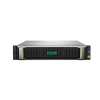
Bạn vui lòng nhập đúng số điện thoại để chúng tôi sẽ gọi xác nhận đơn hàng trước khi giao hàng. Xin cảm ơn!

 English
English
